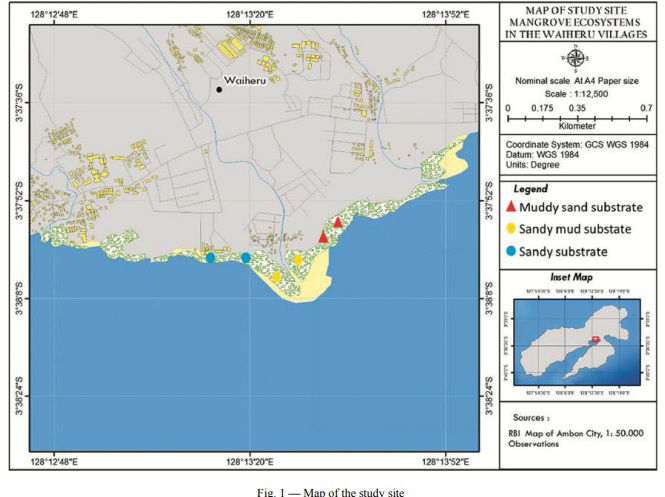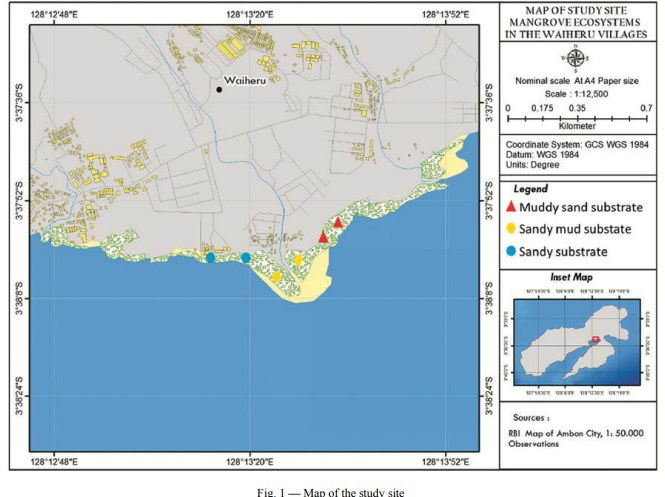Global warming potential of nitrous oxide fluxes from sediments of mangrove ecosystem in Waiheru coastal area, Ambon Bay I Kesaulya & Rahman*

Mangrove ecosystems can be a source or a sink of N2O and other greenhouse gases. The Inner Ambon Bay area, including the Waiheru coast, gets organic matter inputs deposited in sediments, which has the potential to trigger an increase in greenhouse gas flux. This research was conducted to evaluate the flux and global warming potential of N2O in sediments of the mangrove ecosystem in the area of Waiheru coastal, Ambon Bay. The sediment-trapped gas was collected from the chambers of three different types of sediments viz. sandy, muddy sand, and sandy mud sediments. The gas was extracted from chambers using a syringe and injected into the 10 ml glass bottle. N2O concentrations in the samples were analyzed using gas chromatography. Average N2O concentrations were compared between samples from different sediments using one-way ANOVA. The result showed that the mean concentration of N2O was significantly different between the sediment types (P < 0.05). The highest N2O flux in mangrove sediments was found in the sandy substrate (0.0278 mg.m-2.h-1) and the lowest in the muddy sand substrate (0.0135 mg.m-2.h-1). The average Global Warming Potential (GWP) in mangrove sediments of Waiheru coastal area was 6.29 CO2-eq mg.m-2.h-1, which was contributed by sandy substrate (8.30 CO2-eq mg.m-2.h-1), sandy mud substrate (6.57 CO2-eq mg.m-2.h-1) and muddy sand substrate (4.01 CO2-eq mg.m-2.h-1). The reported values of GWP were relatively low based on the standard value of IPCC, which is 298 CO2-eq mg.m-2.h-1 indicating that the nitrification and denitrification processes producing N2O gas flux are still in normal condition, which would not cause air pollution apa pun yang Anda katakan di artikel berita/topik Anda.

Introduction Global warming phenomena caused by increasing greenhouse gas emissions are an important issue worldwide. Extensive research has been done to estimate the impact of global warming and highlights an increase in sea surface temperature, sea level rise, rainfall, ocean acidification, oxygen concentration, and wind velocity1,2. Agriculture, human health, and fisheries are at risk of being impacted by the global warming phenomena3,4. Predicted changes, if realized, will cause a decrease in the quality of coastal, marine and freshwater ecosystem5,6, leading to decreasing fisheries production and the loss of income of the local communities7,8. In addition to carbon dioxide (CO2) and methane (CH4), nitrous oxide (N2O) also plays a significant role in driving climate change. N2O has a climate impact potential over 298 times greater than CO2 (ref 9). Microorganisms in the soil produce N2O through nitrification and denitrification processes under both aerobic and anaerobic conditions10. The amount of N2O formed rises notably with the increased concentration of organic material entering aquatic environments11. Formation of N2O generally occurs in wetland ecosystems, especially mangrove ecosystems. The mangrove litter accumulating in mangrove sediment through decomposition can produce and emit N2O and potentially influence climate. Research shows that N2O emission in mangrove sediment varies between 0.03 to 1.58 mg.m-2.h-1(refs. 12-16). The information on the Global Warming Potential (GWP) of N2O flux in Indonesia still needs to be improved, especially in the mangrove ecosystems around Maluku province. It is important to be studied to support the management of mangrove ecosystems based on net zero emissions, especially in the forestry sector. Mangrove ecosystems are present along the coastal areas of Inner Ambon Bay, including locations such as Negeri Lama, Passo, Poka, Nania, and Waiheru. Six species of mangrove trees viz. Avicennia marina, Bruguiera cylindrica, Ceriops tagal, Rhizophora apiculata, Sonneratia alba, and Osbornia octodonta are found in Waiheru coastal waters17,18.
